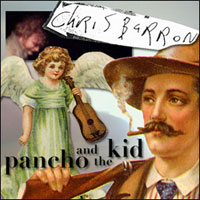
“The rhythm section’s revenge” was the term Jim O’Rourke came up with a few years ago to describe the experimental music duo On Fillmore, featuring bassist Darin Gray and percussionist Glenn Kotche. O’Rourke gets to call them whatever he wants (after all, he’s the musical matchmaker that brought the pair together in the first place), but the places they’ve taken their music over the last decade goes beyond any average definition of the phrase “rhythm section.” Though their individual schedules limit the opportunities for face-to-face playing time these days – Gray has numerous projects going on at any given time, while Kotche’s “day job” with Wilco is pretty all-encompassing by itself – they make it clear that their music is a result of their friendship … and the friendship’s going to be there for a long time to come.
We were able to catch the duo and suspend time as we know it long enough to have some fun talking about their new album Extended Vacation, and the world of On Fillmore – one that includes scuttling crabs, old shortwave radios, bird calls, 200-ton dragons, and nice sunrises.
Ladies and gentlemen, meet Darin Gray and Glenn Kotche – On Fillmore.
BR: No better place to start than at the beginning – is it true that Jim O’Rouke’s responsible for the two of you getting together?
DG: That’s right; we first met in a studio in Chicago. We were making Jim’s Eureka album, which would’ve been … 1997, I believe. That record took a couple of years to make; by the time it came out in ‘99, Glenn and I had been friends for a while. But yeah, you can blame it on Jim. (laughs)
GK: I had actually seen Darin play live with Jim before he brought us together for the Eureka sessions.
BR: So he recruited the two of you separately – with a feeling that you’d make a good team together?
DG: Yes, he did. Jim has done that kind of thing before with people; he has a really great knack for hearing something in one person’s playing and knowing that it’s going to work well with someone else’s playing. And that’s what happened with Glenn and I – it was pretty instant. Really, within an hour of meeting, we were recording.
I think the older you get, the more you appreciate those experiences you have that are, for whatever reason, special. It’s mysterious … when you just automatically start really playing and interacting with somebody, you know? If you could figure out how and why it happens, you’d probably be doing it with a lot more people.
BR: But then it wouldn’t be as special, either.
DG: That’s absolutely true – and this was. We immediately just started making music together and we’ve been best friends ever since.
BR: That’s so cool to hear. I like to think that I’m not cynical, but this old world and the music business can get pretty bloodthirsty and soulless at times –
DG: Oh, absolutely.
BR: – and I love hearing examples of talented people getting together and simply saying, “Hey, I like making music with you.”
GK: Right from the first time I heard Darin playing live with Jim, he was playing in such a way that I was really getting interested – experimenting a lot. I could tell he had a really sound foundation in a lot of different styles. I was really a newbie to the whole scene at that point. You have to remember that prior to Wilco, I’d been playing and touring with singer-songwriters; rock, folk, jazz, stuff like that … but I hadn’t done a whole lot of experimental music. Darin’s like a musical encyclopedia – being around him and playing music together was like going to school. We’d be talking about music and I’d end up getting turned on to great records that really impacted me in a profound way. I realized I had a lot to learn from this guy and really enjoyed playing with him. We both wanted to keep it going at that point.


No Comments comments associated with this post